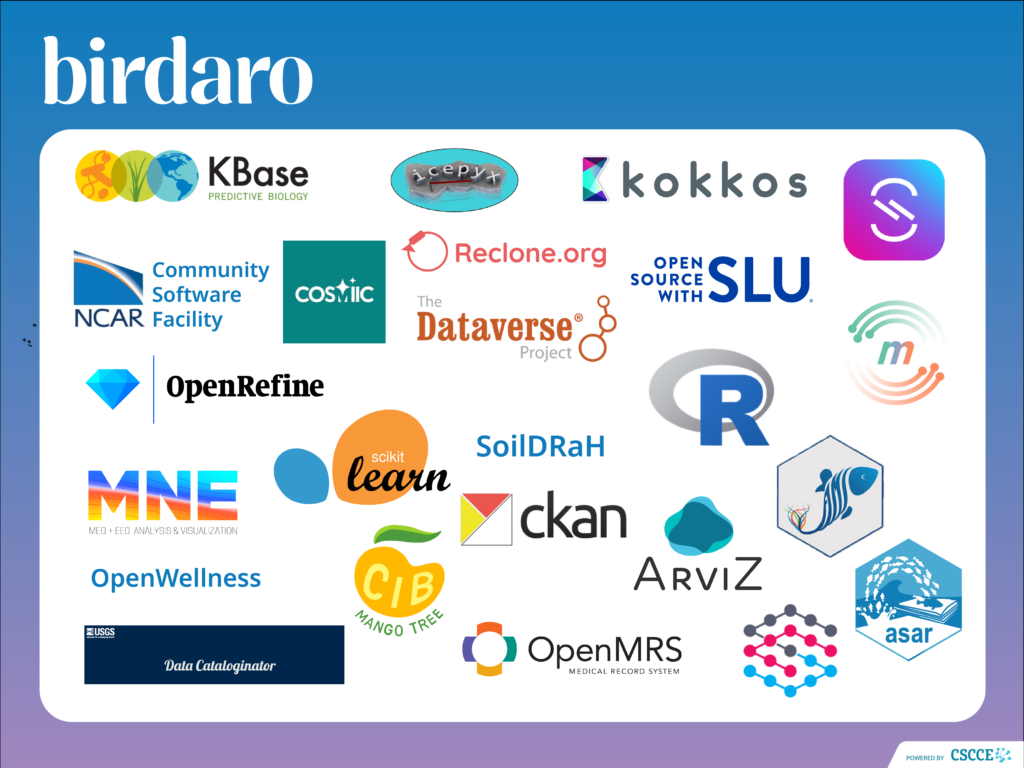At the end of last month we launched the pilot cohort of the Birdaro training program for open-source leaders, which will run for 12 weeks until mid-December 2025.
Thanks to strong interest in the program from a range of projects, we have put together a cohort that represents a variety of focus areas, fiscal homes, project stages and project sizes. You can read more about how we intentionally built this cohort of participants, and used their input to iteratively shape the pilot curriculum in an earlier blog post.
In a new series of five blog posts on the Birdaro website, we’re introducing you to the teams taking part in the Birdaro 2025 pilot cohort. You can click through to read more about each of these projects below, and visit this page of the Birdaro website to learn more about individual team members.

Blog post 1
This post features several projects from research institutions, including a couple of OSPO (open-source program office) or OSPO-like projects:
- OpenWellness – a federally-funded initiative based at the University of Tennessee, Knoxville
- movement – a Wellcome and Gatsby Foundation-funded project at University College London
- Open Source with SLU – an OSPO that exists to mentor and develop open-source projects at St Louis University
- NCAR’s Community Software Facility – and OSPO-like project at the NSF National Center for Atmospheric Research
Find out more about these projects!
Blog post 2
This post highlights the following open-source software, hardware and data projects that “live” within US federal agencies and national labs:
- The US Department of Energy Systems Biology Knowledgebase (KBase) – A platform for data sharing and data analysis in the biological sciences – including via a non-command line interface
- Kokkos – A project that originated in the US Department of Energy National Labs that supports researchers writing C++ applications
- asar: A partially-automated stock reporting system for the US National Oceanic and Atmospheric Administration (NOAA)
- Fisheries Integrated Modeling System (FIMS): A population dynamics model for fisheries health and management, also for NOAA
- USGS Model Catalog / Data Cataloginator: A catalog of all scientific-model products (code, publications, people, data) created by USGS researchers
Find out more about these projects!
Blog post 3
In this post, we feature the following open hardware and open data projects:
- COSMIIC – Creators of the world’s first fully open source active implantable medical device for use in neurological settings
- Reagent Collaboration Network (Reclone) – Helping individuals make and use basic molecular biology reagents locally
- CKAN – One of the most established open source data management systems in the world
- The Dataverse Project – An open source web application to share, preserve, cite, explore, and analyze research data
- Soil Data Rescue and Harmonization (SoilDRaH) – A data harmonization project to support the liberation and use of soil data from archival documents
Find out more about these projects!
Blog post 4
This post summarizes the following open-source software tools for STEM research:
- The R Project – A free software environment for statistical computing and graphics
- RSpace – A platform that enables FAIR (Findable, Accessible, Interoperable, Reusable) data workflows across the entire research lifecycle
- AsyncAPI – An open-source specification for event driven architecture and tooling for asynchronous APIs
- OpenRefine – A desktop application for data cleanup and transformation to other formats
- Scikit-learn – Tools for predictive data analysis and machine learning
Find out more about these projects!
Blog post 5
And in the final post of the series, we share more about the following open-source software tools:
- CIB Mango Tree – OS software that allows non-technical researchers to investigate large social media datasets
- MNE-Python – A tool for analysis and visualization of human neuroimaging data
- ArviZ – A tool for exploratory analysis of Bayesian models
- icepyx – A tool for querying, obtaining, reading, analyzing, and manipulating NASA’s ICESat-2 data
- OpenMRS – An open source Electronic Medical Records platform used around the world
Find out more about these projects!
Additional information
- You can also explore individual participant bios, on the Birdaro website.
- You can find out more about the curriculum we’ve developed to support the pilot cohort participants’ shared interest in governance and documentation here.
If you have any questions about Birdaro, please contact info@birdaro.org.